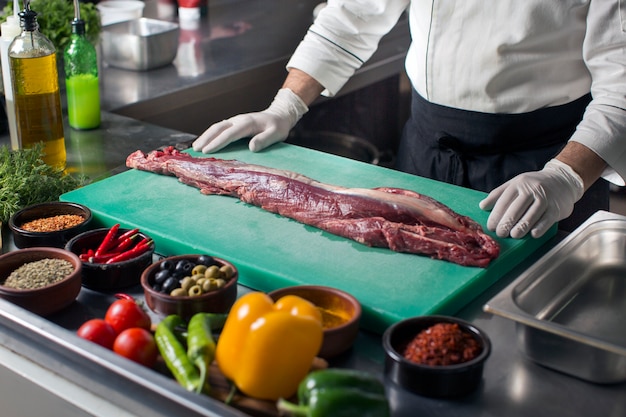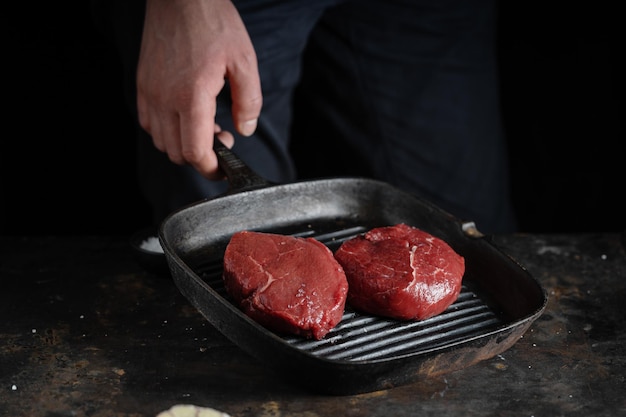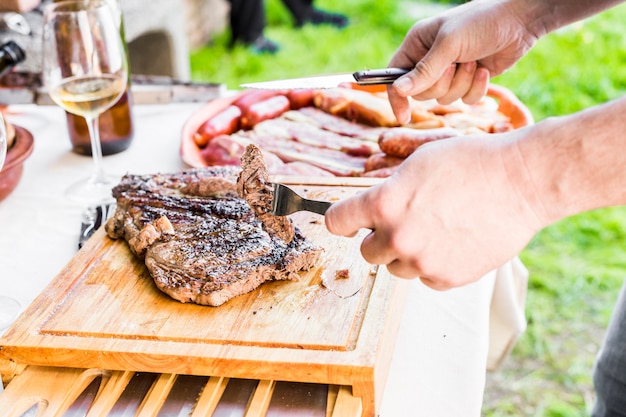(Part 1) Choosing the Prime Rib: The Foundation of Success

Understanding the Cuts: A Guide to the Perfect Cut
Don't be overwhelmed by the different cuts of prime rib you find at the butcher. The most common options are:- standing rib roast: This is the classic choice, a whole section of ribs that offers ample surface area for browning and beautiful presentation.
- Rib Roast: A smaller cut of prime rib, still impressive and perfect for smaller gatherings.
Marbling: The Secret to Tenderness and Flavor
Remember, marbling is your friend. It's the intramuscular fat that gives prime rib its rich flavor and tenderness. Look for a roast with a good amount of marbling, and you'll be rewarded with melt-in-your-mouth deliciousness.Prime Grade: The Guarantee of Quality
Don't settle for anything less than "Prime" grade beef. The USDA Prime grading means the meat meets the highest standards for quality, ensuring you're getting the best possible cut.(Part 2) Preparing the Prime Rib: It's All About the Details

Pat It Dry: The First Step to a Perfect Crust
First things first, pat that prime rib dry with paper towels. We don't want any excess moisture interfering with the searing process, which creates that beautiful, crispy crust.Seasoning: The Art of Balancing Flavors
This is where the magic truly begins. You can choose to keep it simple with just salt and pepper, but remember, you can always get creative with seasonings. I've found that a simple blend of:- 2 tablespoons kosher salt
- 1 tablespoon freshly ground black pepper
- 1 teaspoon garlic powder
- 1 teaspoon onion powder
The Importance of Resting: Letting the Flavors Mingle
Once seasoned, let the prime rib rest at room temperature for about 30 minutes. This allows the flavors to penetrate the meat and makes for a more evenly cooked roast.(Part 3) Roasting the Prime Rib: A Masterclass in Heat and Time

Preheat the Oven: Setting the Stage for a Perfect Roast
Preheat your oven to 230°C (450°F). This high temperature will sear the outside of the meat, locking in the juices and creating that delicious crust.Searing the Prime Rib: A Crucial First Step
Place the prime rib on a roasting rack set in a large roasting pan. Grab a trusty spoon and a bit of oil, and sear the prime rib on all sides, about 5 minutes per side. This creates a beautiful caramelized crust that adds incredible flavor.The Low and Slow Roast: Patience is Key
After searing, turn the oven down to 120°C (250°F). Now, it's time for the low and slow part. Roast the prime rib for about 2-3 hours, or until it reaches your desired level of doneness.internal temperature is King: Getting It Right Every Time
Don't rely on just guessing, use a meat thermometer to ensure your prime rib is cooked to perfection. Here's a handy guide for internal temperatures:| Doneness | Internal Temperature (°C) | Internal Temperature (°F) |
|---|---|---|
| Rare | 47-49 | 117-120 |
| Medium Rare | 52-54 | 125-130 |
| Medium | 57-59 | 135-140 |
| Medium Well | 62-65 | 145-150 |
| Well Done | 68-71 | 155-160 |
Resting the Prime Rib: Allowing the Juices to Redistribute
Once the prime rib is cooked, take it out of the oven and let it rest for at least 15 minutes before carving. This allows the juices to redistribute throughout the meat, ensuring a tender and juicy roast.(Part 4) Carving the Prime Rib: A Culinary Ballet
The moment you've been waiting for has arrived – it's carving time! But hold your horses, carving a prime rib isn't just about hacking away at it. Think of it as a delicate ballet, where each slice is a graceful movement.Tools of the Trade: The Essential Equipment
You'll need a sharp carving knife, preferably one that's long and sturdy. A carving fork is also essential for holding the roast in place while you slice.Slicing with Precision: Achieving Thin, Even Slices
Start by slicing between the ribs. Then, slice across the grain of the meat, making thin slices that are about 1/4 inch thick. This ensures that each slice is tender and melts in your mouth.Arranging the Masterpiece: Presentation Matters
Now, arrange those beautifully carved slices on a platter. You can even add some sprigs of rosemary or slices of lemon for extra flair. Remember, presentation is just as important as flavor!(Part 5) Serving the Prime Rib: A Feast for the Senses
The moment of truth has arrived – it's time to enjoy your masterpiece! This is the grand finale, the culmination of all your hard work.Accompanying Sides: Elevating the Flavor
Prime rib is best served with classic sides that complement its rich flavor. Consider:- mashed potatoes: Creamy and comforting, they provide a perfect balance to the meat's richness.
- Roasted vegetables: Add some color and freshness with roasted vegetables like asparagus, Brussels sprouts, or carrots.
- Mushroom sauce: A rich and savory sauce that adds another layer of flavor to the prime rib.
- Salad: A crisp and refreshing salad provides a nice contrast to the richness of the prime rib.
Presentation is Key: A Visual Delight
Don't forget about presentation! Arrange your prime rib slices on a platter with your chosen sides. A few decorative garnishes like fresh herbs or lemon wedges can elevate the visual appeal of your dish.Enjoy the Feast: Savor the Moment
Take a moment to admire your masterpiece. Then, dig in and savor the moment!(Part 6) Mastering the Sauce: Elevating Your Prime Rib
A good sauce can transform a dish from good to extraordinary, and prime rib is no exception. It's the final touch, the crowning glory that elevates the entire culinary experience.Au Jus: A Classic Complement
Au jus, meaning "with juice," is a simple and flavorful sauce made from the pan drippings. Just scrape the pan drippings after roasting, deglaze it with some red wine or beef broth, simmer for a few minutes, and strain it for a rich and delicious sauce.Horseradish Cream: A Tangy Delight
For a touch of tangy creaminess, whip up some horseradish cream. It's simple to make and adds a delightful contrast to the richness of the prime rib.Mushroom Sauce: A Rich and Savory Option
If you prefer a more robust flavor, a mushroom sauce is a perfect choice. Sauté mushrooms in butter until tender, add a splash of red wine and some beef broth, and simmer until the sauce thickens. Season to taste, and enjoy!(Part 7) Leftover Prime Rib Delights: Transforming Culinary LeftoversDon't let those precious prime rib leftovers go to waste! They're a culinary treasure waiting to be transformed into new dishes.
Prime Rib Sandwiches: A Classic Favorite
Slice the leftover prime rib and create delicious sandwiches on crusty bread with horseradish cream, arugula, and a touch of tomato. It's a simple yet satisfying way to enjoy those delicious leftovers.Prime Rib Hash: A Hearty and Flavorful Dish
Dice up the leftover prime rib and combine it with potatoes, onions, and peppers for a hearty and flavorful hash. It's a perfect way to use up the leftover meat and make a satisfying meal.Prime Rib Soup: A Comforting and Satisfying Option
Add the leftover prime rib to a hearty soup base with vegetables and broth for a comforting and satisfying meal. It's a great way to stretch those leftovers and enjoy them in a different format.(Part 8) Tips for Prime Rib Success: Mastering the ArtHere are a few extra tips to ensure your prime rib is a complete triumph:- Don't overcook it: Prime rib is best served medium-rare to medium, so avoid overcooking it.
- Use a meat thermometer: This ensures that your prime rib is cooked to your desired doneness.
- Let it rest: After cooking, let the prime rib rest for at least 15 minutes before carving. This allows the juices to redistribute throughout the meat.
- Experiment with seasonings and sauces: Don't be afraid to get creative with your seasonings and sauces.
FAQs: Your Prime Rib Questions Answered
How long should I cook a prime rib?
The cooking time for a prime rib will vary depending on its size and the desired doneness. As a general rule, you should cook it for about 15-20 minutes per pound at 120°C (250°F).Can I cook a prime rib on the grill?
Absolutely! You can cook a prime rib on the grill, but you'll need to use indirect heat and maintain a steady temperature.What can I serve with prime rib?
Prime rib pairs well with classic sides like mashed potatoes, roasted vegetables, and mushroom sauce. You can also serve it with a simple salad or a baked potato.Can I freeze leftover prime rib?
Yes, you can freeze leftover prime rib. Wrap it tightly in plastic wrap and then in aluminum foil. It can be frozen for up to 3 months.What is the best way to reheat leftover prime rib?
You can reheat leftover prime rib in the oven, on the stovetop, or in the microwave. Just be sure to heat it slowly and evenly to avoid drying it out.Now, you're ready to conquer the art of prime rib! Armed with this knowledge, you can impress your guests with a magnificent roast that's guaranteed to be the highlight of any gathering. Happy cooking!Everyone is watching

How to Cook Frozen Lobster Tails Perfectly: A Step-by-Step Guide
RecipesLobster. Just the word conjures up images of lavish meals, special occasions, and a taste of luxury. But let's...

Pigs in a Blanket Cooking Time: How Long to Bake for Perfect Results
RecipesAh, pigs in a blanket. Just the name conjures up images of those delightful little parcels of crispy pastry en...

Pork Fillet Cooking Time: How Long to Cook It Perfectly
RecipesPork fillet, or tenderloin as it's sometimes called, is a real favourite in our house. It's so versatile, and...

The Ultimate Guide to Cooking Delicious Frankfurters
RecipesLet's face it, we all love a good frankfurter. It's a classic, simple, and always satisfying. But let's be rea...

The Ultimate Guide to Tender, Juicy Pulled Pork
RecipesRight, let's talk pulled pork. It's one of those dishes that just screams "comfort food," doesn't it? I mean...
